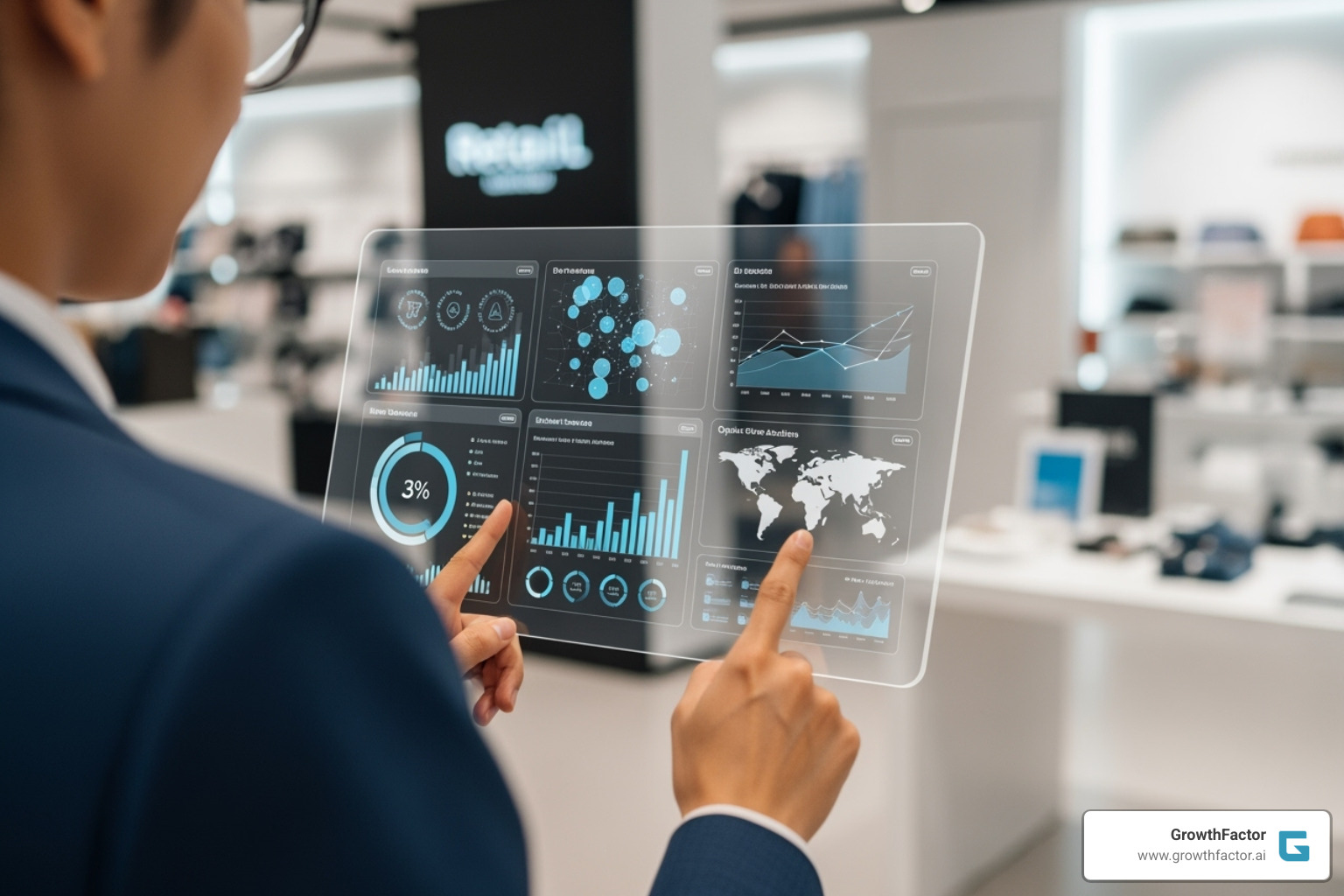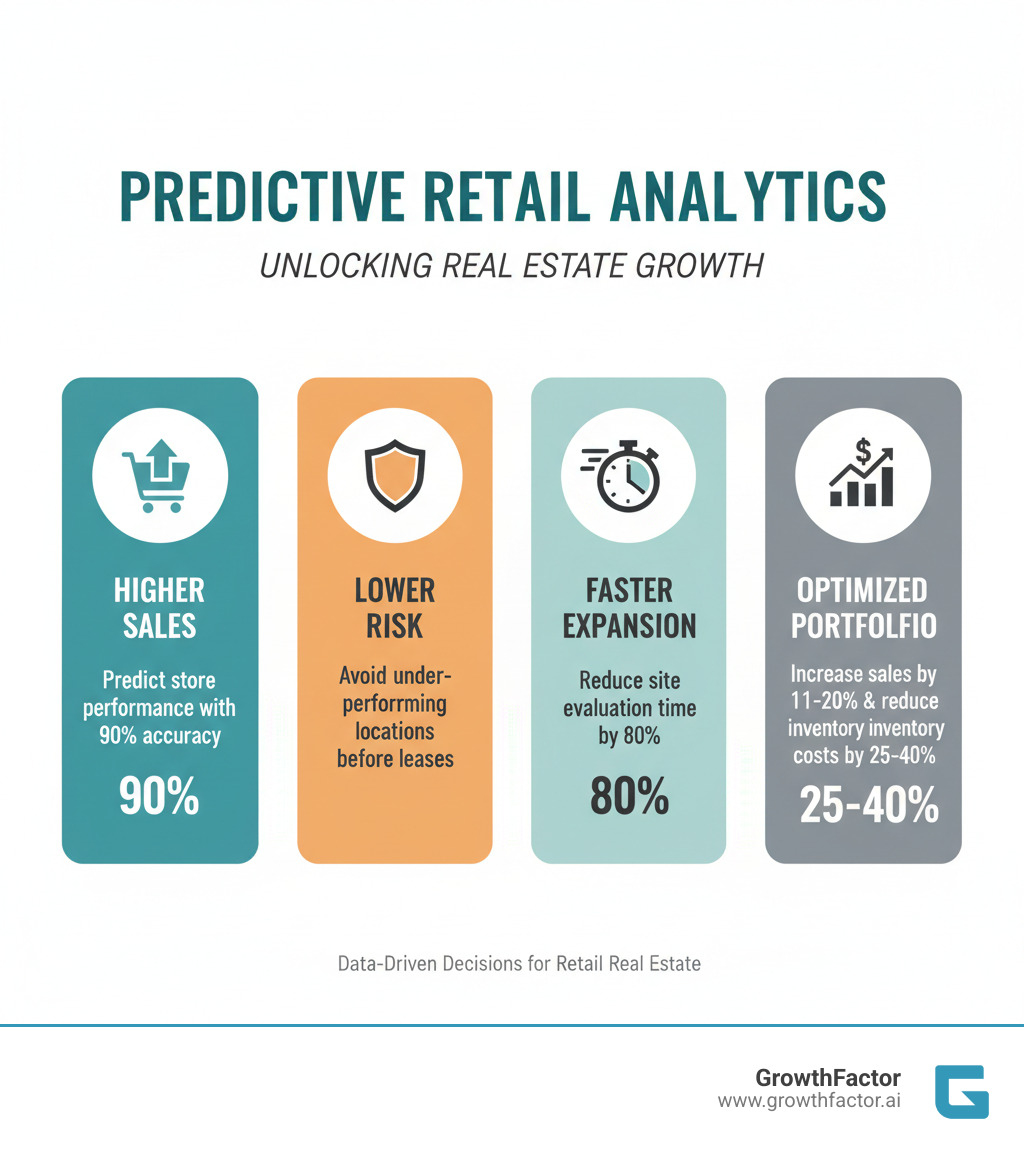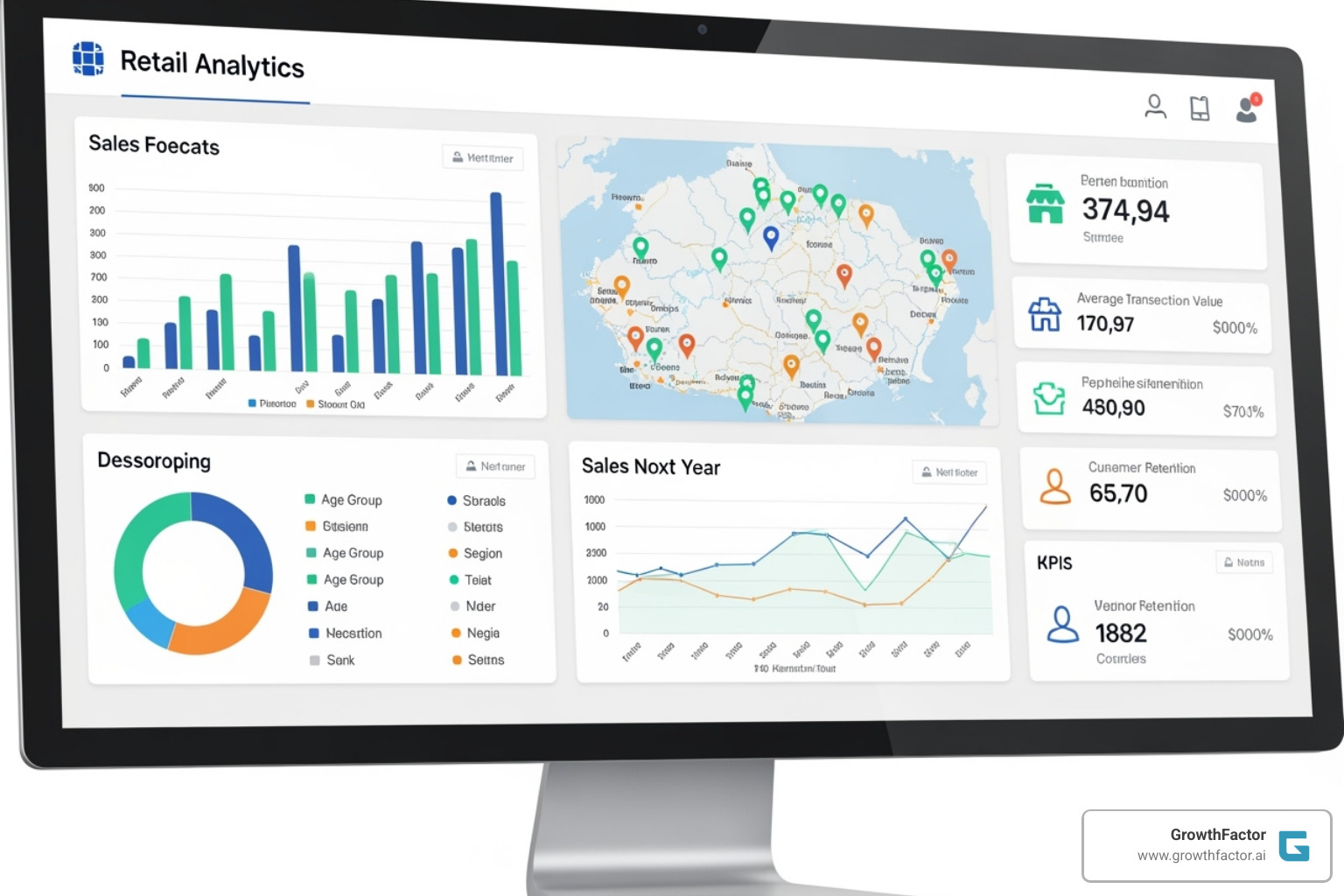Unlock Growth: The Data-Driven Edge in Retail Real Estate
The New Blueprint for Retail Success

Predictive retail analytics is changing how retailers make location decisions. By using historical data, statistical models, and machine learning, it forecasts future outcomes, allowing businesses to predict store performance, identify optimal expansion opportunities, and reduce risk before signing a lease. This data-driven approach replaces gut feelings and expensive, slow-moving consultants.
The stakes are high. The retail analytics market is projected to hit $31.08 billion by 2032, up from $7.56 billion in 2023. Meanwhile, inventory distortion costs retailers nearly $800 billion globally. For growing chains, the traditional site selection process—slow, manual, and based on incomplete information—is broken.
Predictive analytics offers a solution. Retailers using these tools can evaluate hundreds of sites in days, achieve 90% forecasting accuracy, and reduce site evaluation time by 80%. This can lead to a 60% rise in operating profitability.

I'm Clyde Christian Anderson, founder of GrowthFactor.ai, and I've spent my career in American retail—from loading trucks in warehouses at age 15 to leading real estate strategy. I founded GrowthFactor because I experienced the frustration of trying to evaluate sites without the right tools, and I've since used predictive retail analytics to help clients open 550+ locations with a 99.8% success rate. This guide will show you how to leverage the same data-driven approach to transform your expansion strategy.
Common predictive retail analytics vocab:
- market entry strategy
- retail market research
- store location strategy
What is Predictive Retail Analytics in Real Estate?
In retail real estate, predictive analytics moves beyond intuition. It uses historical data—from sales figures and customer demographics to competitive activity—to forecast future store performance with remarkable accuracy. Instead of just looking at what has happened, we ask, "What will happen?" and "What should we do about it?"
This approach leverages machine learning algorithms to find hidden patterns in vast datasets that influence retail success. It provides a significant competitive edge, allowing retailers to proactively identify prime locations and avoid costly missteps.
The Analytics Ladder: From Hindsight to Foresight
To understand its power, it helps to see where predictive analytics sits on the "analytics ladder."
- Descriptive Analytics (What happened?): Summarizes past data. Think sales reports or inventory levels. It provides a snapshot of the past.
- Diagnostic Analytics (Why did it happen?): Dives deeper to find the root causes of trends or anomalies, such as why sales for a specific product dropped.
- Predictive Analytics (What will happen?): Uses historical data and machine learning to forecast future outcomes, like which new store location is most likely to hit its sales targets.
- Prescriptive Analytics (What should we do?): Recommends specific actions to achieve desired outcomes, such as which neighborhood to open a store in and what to stock. This level leverages advanced AI, which you can learn more about in our resources on AI-Driven Analytics.
Core Applications for Predictive Retail Analytics
The magic of predictive retail analytics happens when we move from theory to practice. The applications touch nearly every corner of retail, from merchandising to marketing, and the payoff is substantial: businesses that use big data in their operations can see a 60% rise in operating profitability.
For retail real estate, these applications are transformative. They reshape expansion and portfolio management by anticipating opportunities and challenges, predicting store performance with high accuracy, and reducing risk before signing a lease.

Data-Driven Site Selection and Expansion
Gut feelings about store locations don't pay the rent. Predictive retail analytics transforms site selection from an art into a science by augmenting human expertise with data.
Before breaking ground, we can forecast a location's performance by analyzing demographics and psychographics to find where your ideal customers live and shop. We then layer in foot traffic and accessibility data to understand real-world movement patterns, as detailed in our Foot Traffic Analysis Complete Guide. Finally, a competitive landscape analysis identifies underserved markets.
By combining these inputs with historical sales data, we can predict sales potential with up to 90% accuracy. This turns a multi-million dollar gamble into a calculated investment. For more on this, see our Sales Forecasting Tips for Retail Site Selection. Analytics also helps optimize store formats for specific locations, which you can streamline with Retail Expansion Planning Software.
Optimizing Your Real Estate Portfolio
Opening great stores is only half the battle; managing the entire portfolio for peak performance is the ongoing challenge. Predictive analytics provides the tools for active management, flagging underperforming locations early and enabling data-backed decisions on interventions or closures.
A powerful application is inter-store inventory balancing. Inventory distortion costs retailers nearly $800 billion globally. Predictive analytics identifies potential imbalances and recommends inventory transfers based on forecasted demand. This can decrease inventory costs by 25-40% and increase sales by 11-20%. Our Real Estate Portfolio Optimization tools help coordinate this across your portfolio. Analytics also helps optimize store layouts and offerings based on localized data, ensuring each location is custom to its unique market.
Enhancing Supply Chain and Inventory Strategy
Store locations have a massive impact on supply chain efficiency. Predictive retail analytics provides the visibility to model optimal shipping routes and schedules, addressing inefficiencies that exist in the 63% of businesses that don't use technology to monitor their supply chain.
At the core is retail demand forecasting. Machine learning can achieve 90% demand forecasting accuracy with a three-month lead time, helping avoid both overstocking and stockouts. Our guide on Retail Demand Forecasting explores these techniques.
Even weather forecasting plays a critical role. By cross-referencing weather patterns with sales data, models can predict demand spikes for certain products (e.g., winter coats during a cold snap) and adjust inventory levels accordingly. This turns an unpredictable variable into a competitive advantage.
Building Your Predictive Analytics Strategy
A successful predictive retail analytics strategy is an ecosystem that turns raw data into profitable decisions. It requires the right systems, team, and culture. The journey begins with clear business objectives and follows a structured path.

Key steps include:
- Defining Business Objectives: Start with a clear goal, such as optimizing site selection or reducing inventory costs.
- Data Collection and Integration: Gather data from all sources (POS, CRM, etc.) into a unified platform.
- Data Quality and Governance: Ensure data is clean and consistent. "Garbage in, garbage out" is the rule in data science.
- Model Development and Validation: Build and test predictive models using machine learning to find patterns that forecast outcomes.
- Deployment and Integration: Embed insights directly into daily operations and decision-making processes.
- Continuous Monitoring and Refinement: Constantly monitor, retrain, and adjust models as market conditions change.
- Fostering the Right Talent and Culture: Build a team that knows how to use the tools and a culture that trusts data to augment human expertise.
Key Data Inputs for Accurate Predictions
The accuracy of your predictions depends on the quality and breadth of your data. Key inputs include:
- Customer Data: Demographics (age, income), psychographics (lifestyles, values), and purchase history.
- Transactional Data: Details of every sale, including product, price, time, and location.
- Location Data: Trade area demographics, foot traffic patterns, local infrastructure, and zoning regulations. Our Location Intelligence Platform Complete Guide explores this in depth.
- Competitor Data: Locations, pricing strategies, and promotional activities of rivals.
- External Factors: Economic indicators, seasonal trends, weather data, and social media sentiment.
Data quality is paramount. With up to 60% of retailers' inventory records being inaccurate, clean data isn't optional—it's the foundation of a sound strategy.
Overcoming Common Adoption Challenges
Implementing predictive analytics comes with problems. Understanding them upfront can save you frustration.
- Data Quality and Silos: Data is often scattered and inconsistent across different systems. Unifying it is a major, but necessary, effort.
- Cultural Resistance: Experienced managers may be hesitant to trust algorithms over intuition. Position analytics as a tool that augments, not replaces, human expertise.
- Talent and Skill Gaps: Finding and retaining data scientists with practical retail knowledge can be difficult.
- Cost of Implementation: The upfront investment can seem daunting, but the potential for a 60% rise in operating profitability and a high ROI makes it worthwhile.
- Data Security and Privacy: You must balance analytical needs with strict privacy regulations like GDPR and CCPA, which requires investment in secure, transparent data handling.
Overcoming these challenges requires a strategic commitment, collaboration between teams, and investment in training and scalable technology.
The Future of Retail Real Estate Intelligence
Predictive retail analytics is powerful today, but we're on the verge of an even greater change. The future is about making real estate decisions with near-instant precision, adapting to market shifts in real-time.
The Expanding Role of AI and Machine Learning
AI and machine learning are the foundation of what's next.
- Automated Machine Learning (AutoML) is democratizing analytics. These systems automatically test and select the best predictive models, giving smaller retailers access to insights that once required enterprise-level resources.
- Deeper Pattern Recognition allows AI to spot complex relationships in data that human analysts might miss, such as how proximity to certain businesses impacts store performance.
- More Accurate Forecasting Models using deep learning and neural networks are pushing predictive precision to new levels. This evolution is central to our AI for Real Estate approach, as we integrate these capabilities into practical tools for retailers.
Real-Time Analytics and Dynamic Optimization
The future isn't just about better predictions; it's about acting on them instantly. The traditional model of quarterly reviews is becoming obsolete.
- Adapting to Market Changes Instantly: An analytics platform can detect a sudden population surge or a drop in foot traffic and immediately flag an opportunity or a risk, allowing for rapid response.
- Dynamic Adjustments: Real-time capabilities extend to dynamic pricing based on local demand or instant inventory rebalancing between stores to prevent stockouts during a demand surge.
The goal is proactive decision-making. We're shifting from asking "What happened?" to "What's happening now, and what should we do?" This transforms retail real estate from a reactive discipline into a proactive strategic advantage, which is the core of modern Commercial Real Estate Tech.
Frequently Asked Questions about Predictive Retail Analytics
How does predictive analytics differ from traditional business intelligence?
Traditional Business Intelligence (BI) looks backward to answer "what happened" and "why." It uses historical data to create reports and dashboards. Predictive retail analytics looks forward to answer "what will happen" and "what should we do." It uses data to forecast future outcomes and recommend actions, enabling proactive decision-making. Both are crucial, but predictive analytics empowers you to shape the future.
What kind of data is most important for retail site selection?
A comprehensive picture requires diverse data. The most critical types include:
- Demographic and Psychographic Data: Understands the purchasing power, needs, and lifestyles of potential customers in the trade area.
- Foot Traffic Patterns: Measures the volume and characteristics of people passing a potential site.
- Competitor Locations: Helps identify market gaps and areas of high competition.
- Local Economic Indicators: Provides insight into the economic health and growth potential of an area.
- Sales Data from Comparable Stores: Offers a strong baseline for forecasting sales at a new location.
Synthesizing these inputs allows for robust models that accurately forecast a new location's success.
Can small retailers benefit from predictive analytics?
Yes, absolutely. Predictive analytics is not just for giants.
- Accessible Solutions: Modern cloud-based platforms are affordable and scalable for smaller businesses without requiring massive upfront investment.
- High Impact: Small retailers can focus on specific goals like local customer analysis or inventory optimization for significant gains. The potential for a 60% rise in operating profitability applies to businesses of all sizes.
- Competitive Edge: Data-driven decisions allow small retailers to outmaneuver larger competitors who may be slower to adapt.
At GrowthFactor, our scalable plans are designed to help businesses of all sizes leverage predictive analytics for growth.
Gain Your Competitive Edge with Data-Driven Decisions
In today's retail environment, relying on gut feelings is a recipe for falling behind. Predictive retail analytics is no longer a luxury but a necessity for survival and growth. It's about augmenting human judgment with data to turn uncertain gambles into calculated, confident decisions.
A data-driven approach improves every aspect of your business. You can increase sales by selecting optimal locations, improve profitability by cutting waste from inventory distortion, improve the customer experience by anticipating needs, and mitigate risk by spotting challenges early.
At GrowthFactor, we help retailers turn data into action. Our AI-improved platform and dedicated analyst services streamline site selection and deal tracking, helping you identify high-potential locations and optimize your real estate portfolio with confidence. Our scalable plans are designed for retailers of all sizes, from growing chains to established brands.
The future of retail belongs to those who can see it coming. Don't let outdated methods hold you back.
Explore our all-in-one real estate platform for retail and find how we can help you turn data into your most powerful competitive advantage.
Citations
The human algorithm
Request Your demo
Schedule meeting
Or submit your information below and we'll be in touch to schedule.




